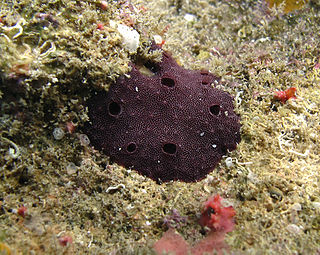
Demosponges are the most diverse class in the phylum Porifera. They include 76.2% of all species of sponges with nearly 8,800 species worldwide. They are sponges with a soft body that covers a hard, often massive skeleton made of calcium carbonate, either aragonite or calcite. They are predominantly leuconoid in structure. Their "skeletons" are made of spicules consisting of fibers of the protein spongin, the mineral silica, or both. Where spicules of silica are present, they have a different shape from those in the otherwise similar glass sponges.

Dendroceratida is an order of sponges of the class Demospongiae. They are typically found in shallow coastal and tidal areas of most coasts around the world. They are generally characterized by concentric layers of fibers containing spongin, and by large flagellated chambers that open directly into the exhalant canals. Along with the Dictyoceratida, it is one of the two orders of demosponges that make up the keratose or "horny" sponges, in which a mineral skeleton is minimal or absent and a skeleton of organic spongin-containing fibers is present instead.

Spongia is a genus of marine sponges in the family Spongiidae, originally described by Linnaeus in 1759, containing more than 60 species. Some species, including Spongia officinalis, are used as cleaning tools, but have mostly been replaced in that use by synthetic or plant material.

Tethya is a genus of sea sponges belonging to the family Tethyidae. Members of this genus all have a spherical body form and some are known to be able to move at speeds of between 1 and 4 mm per day.

Clathria is a large genus of demosponges in the family Microcionidae.

Ircinia is a genus of sea sponges in the family Irciniidae.
Irciniidae is a family of sea sponges in the order Dictyoceratida.

Darwinellidae is a family of sponges in the order Dendroceratida.
Dictyodendrillidae is a family of sponges in the order Dendroceratida.

Amphimedon is a genus of sponges with over 60 described species. In 2009, Amphimedon queenslandica was the first species of sponge to have its genome sequenced.

Callyspongia is a genus of demosponges in the family Callyspongiidae.
Neopetrosia proxima is a species of marine petrosiid sponge native to the tropical and subtropical waters of the western Atlantic Ocean.
Dysidea arenaria is a species of marine sponge (poriferan) found in the Pacific Ocean. It is a member of the order Dictyoceratida, one of two sponge orders that make up the keratose or "horny" sponges in which a mineral skeleton is absent and a skeleton of organic fibers is present instead.

Carteriospongia is a genus of sea sponges in the family Thorectidae.

Clathria (Clathria) is a subgenus of demosponge in the family Microcionidae.
Amphoriscus is a genus of calcareous sponges in the family Amphoriscidae.
Citronia is a genus of sea sponges in the family Dysideidae. It consists of one species, Citronia vasiformis(Bergquist, 1995).
Smenospongia is a genus of demosponges in the family Thorectidae.

Mycale is a genus of demosponge with 240 recognised species in 11 subgenera. It has been a large genus with multiple subdivisions since it was first described in 1867.










